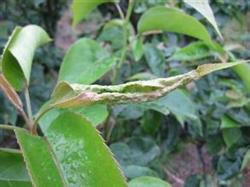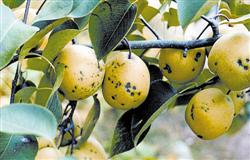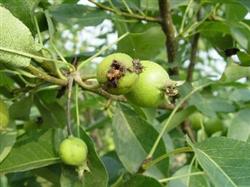Control of pear aphid diseases and insect pests

Pear aphid, also known as pear aphid, pear leaf aphid, commonly known as greasy insect. It occurs in pear areas all over the country, and it is one of the main insects of pear trees. When the damage is serious, it will cause early defoliation and affect the yield and flower bud differentiation in the same year. This insect belongs to Homoptera, Aphididae. 1. Harmful: adults and nymphs gather sprouts, leaves and shoots to suck juice. When the bud is seriously damaged, it cannot be opened normally. Pear leaves become deformed after being damaged, causing the leaves to roll downward into a tube. 2. Morphological characteristics: wingless female aphids are oval, green to yellowish green, about 2 mm long and 1.1 mm wide, mouthparts black, compound eyes reddish brown, antennae black. The end of the abdominal canal is black and cylindrical. Winged viviparous female aphid, long ovate, 1.8 mm long and 0.75 mm wide. The head and chest are black, and the antennae are light black. The wings are transparent and the midvein of the forewings is bifurcated. The ventral tube is cylindrical and the end is black. Eggs: about 0.7 mm long, oval, black and shiny. Nymph: green, similar to the wingless aphid, but smaller. 3. Life history and habits: there are 10 mures and 20 generations a year, overwintering with eggs in the axils of branchlets, fruit platforms and wrinkled skin cracks in branches. The flower buds began to hatch in the early and middle of April, and the peak incubation period was in the middle and late of April. The small aphids are harmful to the buds and turn to the leaves after spreading the leaves, causing the leaves to roll vertically to the front into a barrel, which is serious if it is hot and humid in this period. After falling flowers, the winged aphid began to appear, and some of the winged aphids left the pear tree and migrated to the weeds to continue to breed: from September to October in autumn, the winged aphid migrated back to the pear tree to breed, but the damage was minor, and the sexual aphid mating and spawning overwintering. 4. Prevention and control methods: (1) combined with orchard management, the injured rolled leaves should be removed in time and dealt with centrally. (2) in the middle of April, when the flower bud expands to the flower bud separation stage, and after the winter eggs hatch, but the aphids are not dispersed, the aphids should be sprayed in time. Spray 40% dimethoate EC 1000 times, 50% phoxim EC 1000 times, 50% phoxim EC 1000 times, 2.5% deltamethrin 6000 times. (3) due to the untimely control of aphids, the leaves have been rolled up, so the trunk spraying method can be used. First, use a razor to scrape out a medicine ring around the trunk. The width of the ring is about 10-year-old pear trees, about 6 cm wide. Scrape off the rough skin to reveal the tender skin, then mix 40% dimethoate EC or omethoate EC into a diluent according to one medicine and two parts of water, apply it to the ring with a brush, and finally wrap it with plastic film or waste paper. Generally, aphids are poisoned for about 5 days, and all of them die about 7 days, but the rolled leaves will not flatten out. Therefore, it is appropriate for tree trunks to apply medicine to aphids sooner rather than later. After the aphids are poisoned, the bandages should be removed as soon as possible to avoid tree poisoning or wound decay.
- Prev

Key points of management of pear orchard in spring
In mid-May, some fruit growers in Xinji, Shenzhou and other places found that black spots appeared in the young fruits of some pear varieties after giving medicine to pear trees, which affected the quality of the fruit. In order to investigate the causes of the blackspots, on May 22, Niqun Zhou, Shijiazhuang Fruit Research Institute, Provincial Academy of Agricultural and Forestry Sciences, Liu Jun, Jinzhou Forestry Bureau, and Xie Zhuangji, Zhao County.
- Next

Chemical control of small heart borer in pear
Sex attractant can be hung in the orchard, check the number of trapping insects every day, generally 15 mu of orchard can hang 1. When the number of trapped adults increases sharply, the eggs and fruits are checked every 3 days. When the egg-fruit rate reaches 0.5%-1%, chemical control can be carried out. The main agents are: 1, 20% diflubenzuron suspension or 25% diflubenzuron wettability.
Related
- Moge, come on! The staff of the peasant association in the producing area of cantaloupe were frightened when the crowd gathered.
- Causes and Solutions of low Fruit setting rate of Apple
- Symptoms and control measures of passion fruit virus disease
- Fruit growing lesson: how do apple orchards keep high yields?
- Can you build orchards in the mountains? What are the pros and cons?
- How to manage the coloring period of Crisson grape?
- This paper introduces the processing technology of two kinds of fig products.
- How much is a month for retired teachers in rural areas by 2020?
- How can strawberry planting increase sugar content? We should pay attention to management in many aspects.
- What are the cultivation techniques on how to improve the yield of golden fruit?

